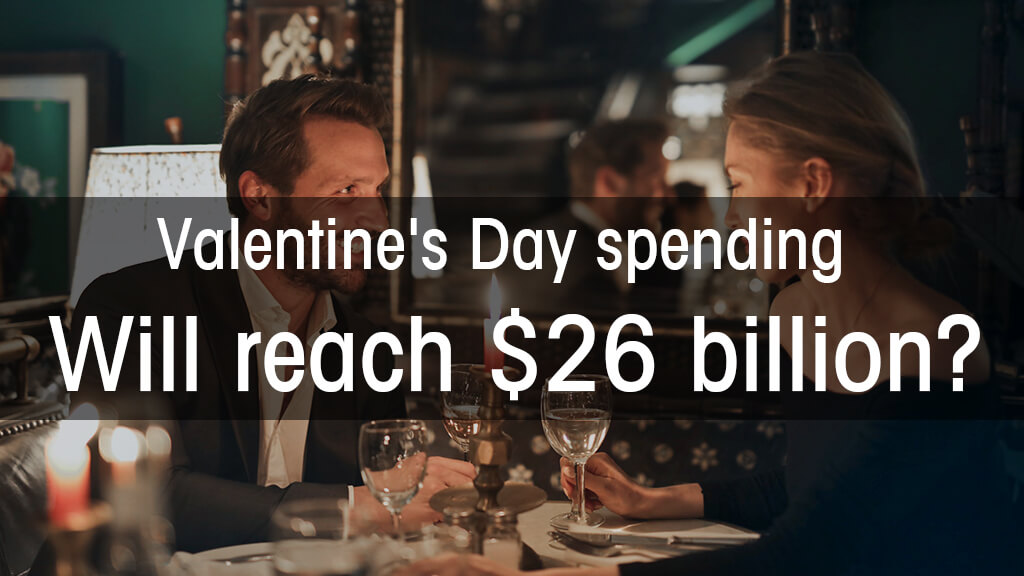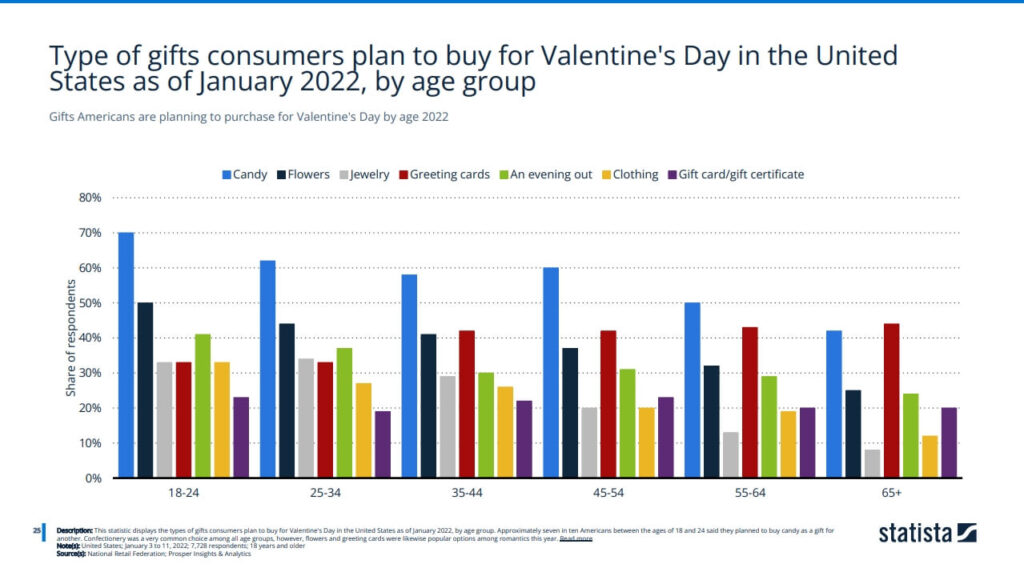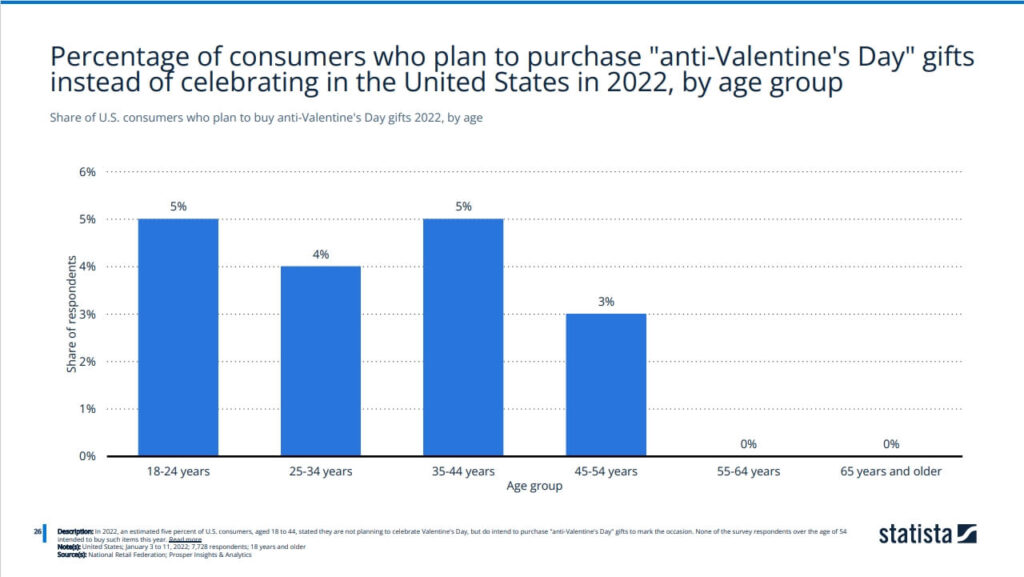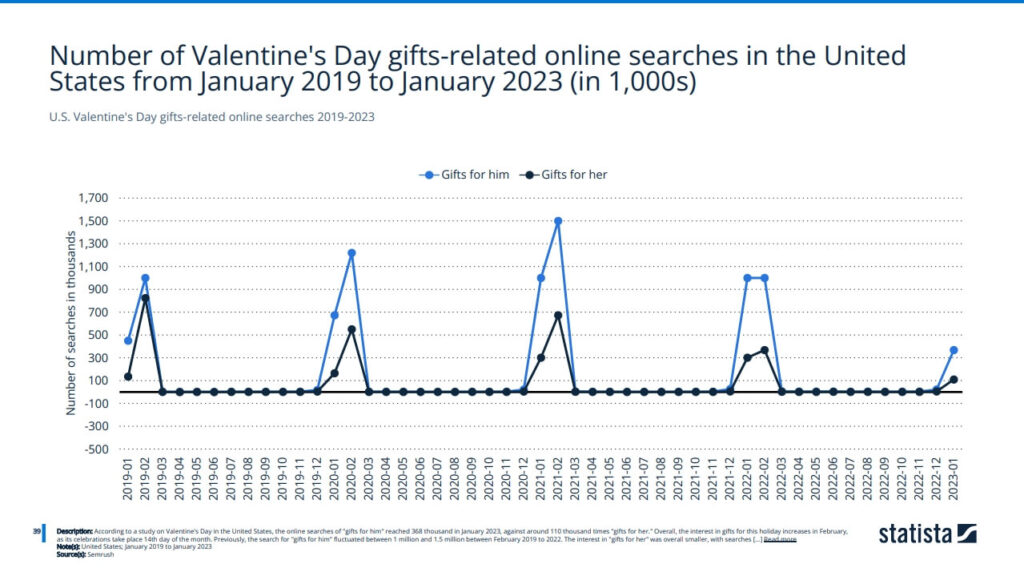
Why Is Valentine’s Day Spending Projected to Hit $26 Billion
as ‘Experience Gifts’ Grow in Popularity?
As the tides of consumer tastes and habits turn, so does the fate of age-old customs. Valentine’s Day remains a day for romance and friendly affection, yet it’s evident that retailers are recognizing a transformation in its celebration. The traditional tokens of love—red roses and heart-shaped chocolates—are no longer the sole focus of shoppers. Could it be time for Valentine’s Day to undergo a brand update?
In the U.S., an anticipated $25.8 billion is projected to be spent for Valentine’s Day festivities this year, cites a report from the National Retail Federation along with Prosper Insights & Analytics. More than half the consumers, 53% to be precise, intend to partake in the holiday’s indulgences, especially those between the ages of 25-34, who show the highest participation rates. Although the day maintains its widespread appeal, emerging trends are gradually giving it a new shape—a fact that hasn’t escaped the notice of retailers.

Moving Beyond Traditional Valentine’s Gifts
Although the timeless trio of flowers, sweets, and cards continue to be go-to Valentine’s gifts, there’s a noticeable shift among the younger crowd who are redefining the essence of the celebration with unconventional gifts. “As consumers are showing increased intention to pamper their partners this year, we’re anticipating changes in the spending patterns across various gift categories,” stated Matthew Shay, NRF President and CEO. Indeed, record expenditures are projected in segments like jewelry ($6.4 billion), apparel ($3 billion), and special evenings ($4.9 billion).
Harley Finkelstein, President of Shopify, remarked to the NRF, “While traditional presents such as candles, jewelry, loungewear, and fragrances retain their charm, there’s a growing preference for atypical gifts that offer experiences. We notice people are more inclined to mix their favorite cocktail with a newly bought mixology kit, plan future trips with trendy travel gear, or add a twist to their game nights with fun additions like table shuffleboard.” This shift underscores an evolving thirst for a more personal and hands-on celebration of the day.
In response, retailers are enhancing their selections to appeal to customers planning to dine in or out, with unique meal options, promotions, and experiences. Grocery retailers, in particular, are broadening their Valentine’s offerings beyond the conventional blooms. Tesco and M&S, renown British supermarkets, have set the benchmark with their sumptuous, amorous meal offers. Both have curated special dine-in assortments—priced at £18 and £25—that feature restaurant-quality main dishes, decadent desserts, and select wines or prosecco. These deals provide a delightful and convenient option for consumers preferring an intimate evening at home or those observing their budgets.

Valentine’s Day’s Evolving Landscape: Embracing a Wider Scope of Love
The way in which Valentine’s Day is recognized is transforming, increasingly embracing a range of relationships and self-appreciation, rather than focusing solely on romantic partners. The occasion is blossoming into a time to commemorate all forms of love, from the bonds of friendship to the importance of self-care. The concept of Galentine’s Day, derived from the 2011 “Parks & Recreation” episode, underscores this shift, becoming as much a part of February’s tradition as Valentine’s Day itself, celebrating friendship and camaraderie.
Joanna Feeley of Trend Bible, a UK trend-forecasting agency, noted to BBC.com that mainstream businesses are broadening their understanding of Valentine’s Day. She suggests that while the day is ripe for rebranding, its essence continues to thrive. Self-gifting, particularly among consumers indulging in self-care, is increasingly common, viewed as a deserved indulgence.
Driving this change are the younger generations, with statistics like those from a Ypulse survey highlighting 28% of Gen Z plans to spend the day with friends or family, as opposed to 15% of Millennials. Brands are pushed to expand their marketing narratives to appeal to this inclusive ethos. Jewelry brands traditionally catered to couples, yet now, lines like Pandora, with its “Be Love” campaign featuring Chloe and Halle Bailey, are transmitting messages of universal love, including self-love.
This presents a valuable opening for brands across diverse segments—from wellness to gastronomy, from beauty to leisure—to tap into the Valentine’s market by offering products that celebrate a wider definition of love. Recognizing how the younger generation values diverse expressions of love during this traditional holiday is pivotal. As brands decipher these nuances, they’re tasked with engineering campaigns that capture the hearts of this all-encompassing customer base. Traditional gifts may soon find themselves alongside innovative, personalized choices such as wellness concoctions and pampering sets, as retailers evolve to keep pace with the changing face of Valentine’s Day.


Table of Contents
**01 Overview**
Consumers planning to shop for Valentine’s Day worldwide 2023, by country
Consumers expecting a Valentine’s Day gift worldwide 2023, by country
U.S. Valentine’s Day sales 2009-2024 06 U.S.
Valentine’s Day planned spending by category 2024
Total expected Valentine’s Day spending on partners in the U.S. 2014-2024
Valentine’s Day total planned spending on gifts in the U.S. by recipient 2024
Valentine’s Day e-commerce spending change in the U.S. 2023, by segment
Annual change in Valentine’s Day gift costs in the U.S. 2021-2022, by category
**02 Celebrating Valentine’s Day**
Plans to celebrate Valentine’s Day in the United States 2007-2024
Plans to celebrate Valentine’s Day in the United States 2023, by age
Leading reasons against Valentine’s Day among U.S. consumers 2022
Share of consumers celebrating Valentine’s Day 2021-2022, by method
**03 Shopping behavior**
Money saving strategies for Valentine’s Day in the United States 2024
Where Americans plan to shop for Valentine’s Day gifts 2024
Gifts U.S. consumers are planning to purchase for Valentine’s Day 2024
Women who planned to buy themselves a Valentine’s Day gift in the U.S. 2022-2024
Impact of inflation on Valentine’s Day plans in the United States 2023
Valentine’s Day shopping plans in the United States 2023, by channel
Is a Valentine’s Day gift worth going into credit card debt for?
Gifts Americans are planning to purchase for Valentine’s Day by age 2022
Share of U.S. consumers who plan to buy anti-Valentine’s Day gifts 2022, by age
**04 Spending intentions**
Planned spend among Americans on Valentine’s Day 2009-2024
Valentine’s Day planned average spending on gifts in the U.S. by recipient 2024
Planned gift spend among Americans on Valentine’s Day by age 2022
U.S. Valentine’s Day planned per person spending on flowers 2010-2022
U.S. Valentine’s Day planned per person spending on candy 2010-2022
U.S. Valentine’s Day planned per person spending on an evening out 2010-2022
U.S. Valentine’s Day planned per person spending on jewelry 2010-2022
U.S. Valentine’s Day planned per person spending on gift cards 2010-2022
05 Online Valentine’s Day searches
U.S. annual change in Valentine’s Day-related keyword searches 2022
U.S. Valentine’s Day-related online search keyword growth 2022
U.S. Valentine’s Day gifts-related online searches 2019-2023 39 U.S. Valentine’s Day decoration-related online searches 2019-2023
U.S. growth in Valentine’s Day decoration-related online search keywords 2022
U.S. Valentine’s Day bouquet-related online search keyword growth 2022
U.S. Valentine’s Day-related online searches 2019-2023 43 U.S. Valentine’s Day definition online searches 2019-2023
This structure represents the main sections and subtopics covered in the provided text regarding the jewelry industry in the UK.
Please contact us for the full version of this report in PDF file.